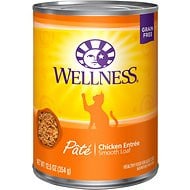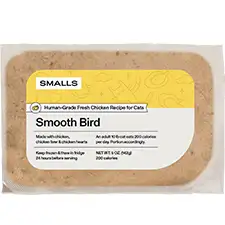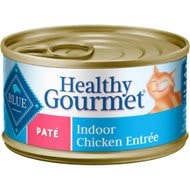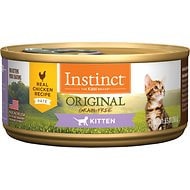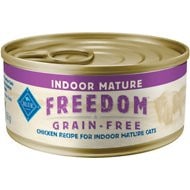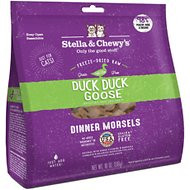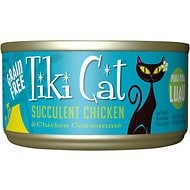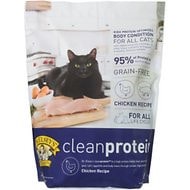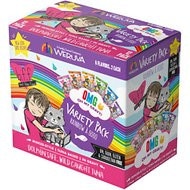Contents
- What Is The Best Cat Food Without Peas, Lentils, Legumes, and Potatoes?
- What Are the Problems with Grain-Free Cat Food?
- What You Need to Know About Peas, Lentils, Legumes, and Potatoes in Cat Food
- What Should You Look for in a Healthy Cat Food?
- How Do We Make Cat Food Recommendations?
- The 9 Best Cat Foods Without Peas, Lentils, Legumes, or Potatoes
- Smalls Fresh Bird Cat Food Delivery
- Wellness Complete Health Pate Chicken Entrée Grain-Free Canned Food
- Blue Buffalo Healthy Gourmet Pate Chicken Entrée Indoor Adult Canned Food
- Instinct by Nature’s Variety Kitten Grain-Free Real Chicken Recipe Wet Food
- Blue Buffalo Freedom Indoor Mature Chicken Recipe Grain-Free Canned Food
- Stella & Chewy’s Duck Duck Goose Dinner Morsels Freeze-Dried Cat Food
- 3 More Top-Rated Cat Foods without Peas, Lentils, Legumes, or Potatoes
- Frequently Asked Questions
Nutrition experts agree that plant-based diets are extremely healthy… for humans any way. There is some concern about meeting your needs for specific nutrients including protein, but it is perfectly possible to create a balanced plant-based diet. Plant foods like peas, lentils, and legumes offer plenty of protein as well as other essential nutrients.
Unfortunately, these foods are not quite as healthy for your cat. If you know anything at all about feline nutrition, you probably know that protein is important. You may also know that your cat is a carnivore and needs meat rather than plants. Ingredients like peas and lentils in cat food often add extra protein, but not in a form your cat can efficiently process. Pet food manufacturers, particularly those selling grain-free diets, don’t tell you that on the label.
In this article, we’ll talk about the role of peas, lentils, legumes, and potatoes in cat food as well as the potential problems they can cause. We’ll also discuss the things you should be looking for in a healthy cat food and provide you with some of our top recommendations. Read on!
What Is The Best Cat Food Without Peas, Lentils, Legumes, and Potatoes?
- Smalls Fresh Food Delivery
- Wellness Complete Health Pate Chicken
- Blue Buffalo Healthy Gourmet Pate Chicken
- Instinct by Nature’s Variety Kitten Grain-Free
- Blue Buffalo Freedom Indoor Mature Chicken
- Stella & Chewy’s Duck Duck Goose Dinner
- Tiki Cat Puka Puka Luau Succulent Chicken in Chicken
- Dr. Elsey’s Clean Protein Chicken Formula Grain-Free
- BFF OMG Rainbow a Gogo Variety Pack Wet Food
What Are the Problems with Grain-Free Cat Food?
When you head to the pet store to shop for cat food, what do you look for? You probably spend a minute or two walking down the aisle, scanning the names on the packages. Words like “chicken,” “real meat,” and “natural” probably catch your eye. But what about the term “grain free?”
The fact that a product is free from something may lead you to believe that it’s better for it. But are grains actually a problem in cat food? Not necessarily
The popularity of grain-free pet foods stems from a rising fear of grain allergies in pets. Pet food manufacturers would have you believe these allergies are more common than they are. In reality, the most common cat food allergens are proteins like chicken, beef, and fish as well as dairy products, eggs, and artificial additives. Whole grains can actually be very nutritious for cats, as they are for humans, but still shouldn’t outweigh the animal protein in your cat’s food.
But what’s the problem with grain-free cat food? One of the biggest issues with grain-free diets is that the carbohydrates used to replace grains are often high in protein and may contain certain harmful ingredients. More protein? What’s the problem?
The problem is that cats are obligate carnivores which means they are biologically evolved to digest animal products, not plants. They have a short digestive tract and lack the digest enzymes needed to digest plant protein, so plant proteins like peas, lentils, and legumes are not particularly beneficial for your cat in terms of nutrition. They may also contain harmful or even toxic ingredients like phytic acid which could impede your cat’s ability to absorb nutrients.
Grain-free diets aren’t all bad, but they are not inherently healthier for your cat than a diet that includes whole grains. The only time you really need to feed your cat grain-free is if he has a diagnosed allergy to grains and your veterinarian recommends it.
What You Need to Know About Peas, Lentils, Legumes, and Potatoes in Cat Food
We’ve already mentioned the fact that peas, lentils, legumes, and potatoes are often used in grain-free foods, but now we want to delve deeper into the problems they can cause.
The biggest problem with ingredients like these is that they can increase the total protein content of the recipe. Even if the first ingredient is fresh meat, there’s no guarantee that the recipe contains more animal than plant protein. Fresh meats contain up to 70% moisture which will be cooked out during processing. Plant proteins, on the other hand, are often already cooked or contain much less water, so they could end up weighing more than the cooked meat in the end. This could mislead consumers into thinking the product is higher in animal protein than it really is.
Aside from increasing the perceived protein content of the cat food, what are the other issues with ingredients like peas in cat food?
First and foremost, you should know that the peas used in pet foods are generally not the fresh green peas you find in the supermarket, they are dried peas. Peas and lentils are legumes, so the issues that apply to them also apply to legumes in general. The problem with these ingredients is that they contain lectins, sugar-binding proteins that plants use as natural defenses against predators. They act as natural insecticides and fungicides.
These lectins are designed to bind or stick to sugars, but they also end up sticking to the lining of the small intestine. This can damage the villi lining the intestine which are responsible for absorbing nutrients. Lectins have also been shown to harm the microflora in the gut that support digestion.
Another problem with legumes in cat food, specifically things like chickpeas, alfalfa, and soy products, is that they contain phytoestrogens. Phytoestrogens mimic or interfere with the estrogen produced in the body by binding themselves to estrogen receptors. This has been linked to issues like delayed puberty, infertility, autoimmune disease, developmental issues, and neurodegenerative disease. Lentils are much lower in phytoestrogen content than soy products, but they still contain phytates which bind to certain minerals like zinc, iron, and calcium which can leech them out of your cat’s body.
So, what’s the problem with potatoes?
One of the issues with potatoes is that much of the potatoes in cat food are in the form of protein. As you remember, plant proteins are less biologically valuable than animal proteins for cats and much cheaper as well. Potato starch is another common ingredient that provides little nutritional value, acting primarily as a binding agent. There is some concern that the glycemic index of potatoes is a little high, meaning that it has a more significant impact on blood sugar and insulin levels than other foods, but these concerns are based on the impact on humans – it may not be quite the same for pets.
The long and short of it is that ingredients like legumes in cat food are less than ideal. They may not cause your pet any immediate harm, especially in small amounts, but they don’t support his optimal nutrition and may lead to problems with digestion and nutrient absorption over time.
What Should You Look for in a Healthy Cat Food?
We’ve spent quite some time talking about ingredients you should avoid in your cat’s food, but what do you need to be looking for? It’s important to remember that your cat is an obligate carnivore, so he has a biological requirement for meat in his diet. More specifically, 26% of his diet for adult cats and 30% for kittens. These are absolute minimums, however, so more protein is usually better. You also want to make sure the recipe is labeled complete and balanced according to AAFCO food nutrient profiles.
Here’s what to look for in cat food:
- Rich in quality animal protein. The majority of your cat’s diet should come from animal sources, including his protein. Named sources of poultry, meat, and fish are ideal, though named by-products like chicken by-products are not necessarily bad. Just avoid generic proteins like meat by-products or poultry meal because you won’t be able to judge the quality easily.
- Moderate healthy fat content. Fat provides your cat with a concentrated source of energy as well as essential fatty acids – it should come from animal ingredients like chicken fat and salmon oil, though plant oils like sunflower oil can provide omega-6s to balance out the omega-3s.
- Low in digestible carbohydrates. Your cat has no biological need for carbohydrates in his diet, so the carb content of your cat’s diet should be low and limited to highly digestible options.
- Fresh fruits and vegetables. Peas and potatoes are not the best vegetables for your cat, but things like leafy greens are. Fresh low-starch vegetables and fruits provide natural sources for key nutrients in a more biologically valuable form than synthetic supplements.
- No corn, wheat, or soy ingredients. In addition to avoiding peas, lentils, legumes, and potatoes in cat food, you should also avoid corn, wheat, and soy ingredients. They offer little to no nutritional value and come with similar issues.
Now that you know what to look for in a healthy cat food, you’re ready to start shopping! Before you do, however, we want to tell you how we make our cat food recommendations so you know whether you can trust the picks we list below.
How Do We Make Cat Food Recommendations?
Choosing a cat food can be tough, especially with so much misinformation out there. We know how much you love your cat and we want what’s best for him just as much as you do! We’ve made it our mission to provide you with the information you need to make smart and healthy choices for your pet. Every pet food we recommend does just meet but exceeds minimum nutrient requirements for cats. They are also made with high-quality ingredients including real animal proteins, healthy animal-based fats, and other digestible whole-food ingredients.
Here are some general requirements for a cat food recipe to receive our stamp of approval:
- A source of high-quality animal protein as the first ingredient
- At least 30% crude protein for kittens and at least 26% for adults
- A minimum of 9% crude fat for kittens and adults
- A balance of omega-3 and omega-6 fatty acids, primarily from animal sources
- A rich blend of nutrients from natural sources and supplements, as needed
- Limited carbohydrate content from digestible sources (like whole grains and veggies)
- No low-quality fillers, by-products, or artificial additives (preservatives, dyes, or flavors)
The 9 Best Cat Foods Without Peas, Lentils, Legumes, or Potatoes
Your cat deserves the highest quality food you can consistently afford, so that’s the best place to start. Once figuring out your budget and picking some reputable brands within that budget, start taking a closer look at the ingredients on the package. Here are some recommendations to get you started:
| Our 2024 Picks: Overall Best Foods without Peas, Lentils, Legumes, or Potatoes | |||
Smalls Fresh Cat Food
|
CHECK PRICE | ||
Wellness Complete Health Pate Chicken
|
CHECK PRICE | ||
Blue Buffalo Healthy Gourmet Pate Chicken
|
CHECK PRICE | ||
Instinct by Nature’s Variety Kitten
|
CHECK PRICE | ||
Blue Buffalo Freedom Indoor Mature Chicken
|
CHECK PRICE | ||
Stella & Chewy’s Duck Duck Goose
|
CHECK PRICE | ||
Tiki Cat Puka Puka Luau Succulent Chicken
|
CHECK PRICE | ||
Dr. Elsey’s CleanProtein Chicken
|
CHECK PRICE | ||
BFF OMG Rainbow a Gogo Variety Pack
|
CHECK PRICE | ||
Smalls Fresh Bird Cat Food Delivery
Our Top Overall Pick: Many pet experts agree that fresh food is best for cats and we’re with them! Smalls is a fresh pet food company that sends deliveries of fresh pet food right to your door. Simply provide some basic information about your cat’s age, breed, weight, and activity level and they’ll customize your order to his calorie needs and send you pre-portioned bags of food. Choose from two recipes – chicken or fish – both of which are free from peas, legumes, lentils, and potatoes. These recipes are cooked in small batches at low heat to preserve the nutritional quality and natural flavor.
Wellness Complete Health Pate Chicken Entrée Grain-Free Canned Food
Most Popular Cat Food without Peas, Lentils, Legumes or Potatoes: If you’re not sure what to feed your cat, you can always go with a popular brand like Wellness. This Complete Health Pate Chicken Entrée is a great option for cat food free from peas, lentils, legumes, and potatoes. It features fresh chicken, chicken liver, and fresh turkey as the top three ingredients, making it incredibly rich in real animal protein. The only carbohydrate ingredients are carrots, cranberries, and ground flaxseed, so the recipe is grain-free as well. This formula contains a fairly limited list of ingredients, making the risk of triggering food allergies fairly low, and it is complete and nutritionally balanced with minimal need for synthetic supplements.
Blue Buffalo Healthy Gourmet Pate Chicken Entrée Indoor Adult Canned Food
Most Affordable Cat Food without Peas, Lentils, Legumes or Potatoes: Cheap cat food isn’t good and good cat food rarely comes cheap, but this Blue Buffalo entrée is very affordable and offers good quality. It features fresh chicken and chicken liver as the top two ingredients with brown rice and sweet potatoes as digestible and nutritious sources of carbohydrate. This recipe contains carrots and cranberry as well for naturel sources of key nutrients to balance out the vitamin and chelated mineral supplements. Overall, this recipe is highly digestible, complete and nutritionally balanced, and full of real chicken flavor your cat will love.
Instinct by Nature’s Variety Kitten Grain-Free Real Chicken Recipe Wet Food
Best Kitten Food without Peas, Lentils, Legumes or Potatoes: Starting your kitten off right with a high-quality diet is essential for long-term health and wellness. This chicken recipe from Instinct by Nature’s Variety is a great choice that also happens to be free from peas, lentils, legumes, and potatoes. It features fresh chicken and beef liver as the main ingredients with fresh salmon as a supplemental source of protein and chicken broth for natural flavor. Dried kelp is the only carbohydrate ingredient and it too provides some supplemental protein. Overall, it is high in protein, low in carbohydrates, and balanced in nutrition with the help of fresh fruits and vegetables.
Blue Buffalo Freedom Indoor Mature Chicken Recipe Grain-Free Canned Food
Best Senior Cat Food without Peas, Lentils, Legumes or Potatoes: Your senior cat still needs plenty of protein in his diet but his needs for calories may decrease. A senior recipe like this chicken formula from Blue Buffalo is a great choice that is also free from peas, lentils, legumes, and potatoes. This recipe contains protein-rich chicken as the main ingredient to help support lean muscle mass and healthy bodyweight. Carrots and sweet potatoes are the primary carbohydrates, both grain-free and rich in nutrients. You’ll also find cranberries and blueberries later in the list which provide natural sources of key vitamins and minerals, balanced out with vitamin and chelated mineral supplements as needed.
Stella & Chewy’s Duck Duck Goose Dinner Morsels Freeze-Dried Cat Food
Best Cat Food without Peas, Lentils, Legumes or Potatoes for Sensitive Stomach: If you’re concerned about food allergies, you’re probably looking for a grain-free diet made with limited ingredients. Though not specifically marketed as a limited ingredient diet, this Stella & Chewy’s Duck Duck Goose Dinner Morsels Freeze-Dried Cat Food is a great option. Not only is it grain-free and free from peas, lentils, legumes, and potatoes, but it contains novel proteins like duck, turkey, and goose to minimize the risk of food allergies. It contains pumpkin seed as the only real source of carbohydrate which also adds healthy fats to the recipe. Plus, because it is freeze-dried and not cooked at high temperatures, the nutritional integrity of the raw ingredients is preserved.
3 More Top-Rated Cat Foods without Peas, Lentils, Legumes, or Potatoes
Tiki Cat Puka Puka Luau Succulent Chicken in Chicken Consomme Grain-Free Canned Food
For a high-protein cat food with no added carbohydrates, try this Tiki Cat Puka Puka Luau Succulent Chicken in Chicken Consomme. This formula features fresh chicken as the main ingredient with chicken broth for flavor and nutrition. It contains sunflower seed oil as a rich source of omega-6 fatty acids with vitamins and chelated minerals to ensure optimal nutritional balance.
Dr. Elsey’s CleanProtein Chicken Formula Grain-Free Dry Food
This Dr. Elsey’s CleanProtein Chicken Formula Grain-Free Dry Food is a little different than many of the cat foods we review because it contains an ingredient called pork protein isolate. It may sound like a scary ingredient, but it is simply a concentrated form of pork protein. Overall, this recipe is very low in carbohydrates and provides a rich blend of omega-3 and omega-6 fatty acids.
BFF OMG Rainbow a Gogo Variety Pack Wet Food Pouches
If you like to offer your cat a variety of foods, this BFF OMG Rainbow a Gogo Variety Pack Wet Food is a great choice. All three recipes feature real animal proteins like tuna, chicken, and beef with no peas, lentils, legumes, or potatoes. Every recipe is low in carbohydrates, rich in essential nutrients, and highly digestible for optimal nutrition.
Frequently Asked Questions
- Should I feed my cat food without grains? Generally speaking, there is no nutritional need to feed your cat grain-free cat food. The exception is for cats who have a diagnosed grain allergy. Even then, you need to be careful about switching to a grain-free cat food without paying attention to the ingredients. High-protein plant foods like legumes, lentils, and peas contain potentially harmful ingredients, so you should avoid cat foods that contain them in high quantities. Fresh vegetables are preferable.
- Are potatoes in cat food always bad? According to Solid Gold Pet Food, one of our preferred brands, potatoes can be both good and bad in pet foods. They are grain-free carbohydrate rich in vitamin C, potassium, and B vitamins in addition to being fairly low in calories. They are also easily digested and generally well tolerated. The problem is that they are high in starch and may have a higher glycemic index rating than fresh vegetables.
- Why should I look for a cat food without corn, wheat, or soy? There are plenty of cat food ingredients you want to look for but just as many you want to avoid. Low-quality grains and fillers are common in cheap cat foods, typically used to add bulk to the product or to increase the protein content. The problem is that cats have trouble digesting these ingredients, so they don’t actually provide much value. This is true for corn, wheat, and soy ingredients.
- How much should I feed my cat? The amount you feed your cat depends on his age, weight, and activity level. Kittens and very active cats have higher needs for calories than adult and senior cats, so keep that in mind. Choose a cat food appropriate for your cat’s life stage and follow the feeding instructions on the package according to your cat’s age and weight. You may want to err on the side of underfeeding for adult and senior cats to prevent obesity, but increase your cat’s daily ration if he becomes sluggish or starts to lose weight.
- How often should I feed my cat? Most cats do well with two meals per day, one in the morning and one in the evening. If you have a kitten, more frequent meals may be recommended to support growth and development. If you’re not sure how often you should be feeding your cat, you can ask your vet for recommendations.
We’ve covered a very complex subject in this article in the best way possible to give you an overview without confusing you too much. The key takeaway here is that you can’t necessarily trust pet food manufacturers to do what’s best for your cat – that’s your job. It’s up to you to understand what the information on a pet food package means and to make your own decision for your cat.
We understand that choosing a cat food can be tough, so we’ve done our best to give you the information you need to make a smart decision. If you’re still confused, don’t worry – you can simply try one of the recipes we’ve recommended above!

